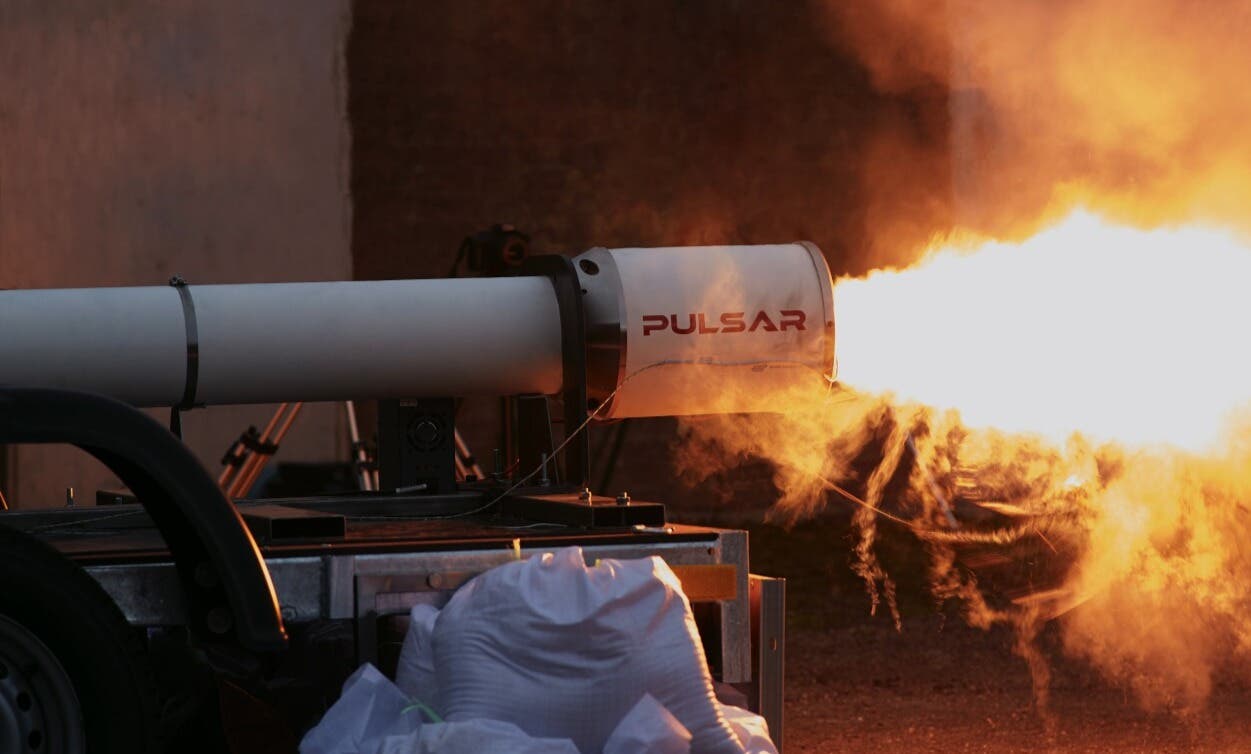Plastic waste-powered rocket could sustainably take humanity to Mars
A nuclear fusion company with lofty aspirations around sustainable space travel, has test-fired a rocket engine powered by plastic waste.

[Nov 27, 2021: Nick Lavars]
Pulsar Fusion, a UK nuclear fusion company based in Bletchley, conducted successful tests at COTEC, a Ministry of Defence military base in Salisbury (CREDIT: Pulsar Fusion)
Pulsar Fusion, a UK-based nuclear fusion company with lofty aspirations around sustainable space travel, has test-fired a rocket engine powered in part by plastic waste. Their hybrid rocket engine is part of an ambitious journey that also involves the development of nuclear fusion technology for high-speed propulsion, which could cut travel times to Mars in half.
Based in Bletchley, they just completed a set of successful tests at COTEC, a Ministry of Defence military base in Salisbury, where their rocket design withstood 20g of vibration, simulating an actual rocket launch.
The company's ultimate milestone – to produce a hyper-speed propulsion engine for interplanetary travel using nuclear fusion technologies – could be realized in just four years.
The idea of incorporating recycled plastic waste into hybrid rocket fuels is something that has been explored before. Virgin Galactic flirted with the idea back in 2014 through the use of a rocket powered by a fuel based on a class of thermoset plastics, though this was swiftly abandoned after a failed test flight. Scottish company Skyrora is another outfit working on such a technology, having successfully tested out its Ecosene fuel made from converted plastic waste.
Pulsar Fusion's CEO is University of Oxford graduate Richard Dinan (right). Fuel derived from recycled plastic has enabled Pulsar Fusion to test its first launch capable, high-power chemical rocket engine in the UK for the first time. (Credit: Pulsar Fusion)
Pulsar Fusion is throwing its hat in the ring with a "green" rocket that uses a hybrid fuel consisting of high density polyethylene (HDPE) and nitrous oxide oxidizer, which is fed into the combustion chamber under regulated pressure through a control valve. HDPE is used in a range of plastic products including bottles, piping and cutting boards, enabling plenty of opportunities to source and recycle this key ingredient of the fuel.
Related Stories
At the UK's Ministry of Defence military base in Salisbury last week, Pulsar Fusion completed the first static tests of its hybrid rocket engine. According to the company, this generated the type of supersonic shock diamonds you'd see in a high temperature, high mass flow rate rocket exhaust, and resulted in dramatic, fiery plume. It plans to follow this up with a demonstration for potential clients this week.
The rocket engine (pictured) proudly displayed the Union flag during testing earlier this month. Rocket engines could be used for a variety of applications, including launching people and satellites into space. (Credit: Pulsar Fusion)
“We are delighted with the UK test firings at COTEC. It is a hugely significant moment and we are proud this rocket is built in the UK," says Pulsar Fusion CEO Richard Dinan. "To have a British rocket test on UK soil is novel. Pulsar is among a very few companies around the world to have built and tested these technologies. We have a team of fantastic scientists with a wealth of experience to thank for these milestones."
The company says potential applications for the "green" rocket engine include launching people and satellites into space, but its vision for space exploration doesn't end there, with plans to develop high-speed propulsion engines based on nuclear fusion and launch them this decade. The idea behind this technology is to recreate the process that takes place inside the Sun, where gravitational forces combine with extreme heat and pressure to smash nuclei into each other to release huge amounts of energy. Scientists have been pursuing this for decades through experimental reactors and though some exciting advances are being made, the technology remains many years away from providing a viable source of energy.
The 'green' rocket is powered by the following fuels: high density polyethylene (HDPE) and nitrous oxide which is called a hybrid. (Credit: Pulsar Fusion)
Which makes Pulsar Fusion's objectives in the space seem highly ambitious indeed. It has been working on its nuclear fusion technology for nine years and is aiming to use powerful electromagnetics to direct the energy released through fusion reactions into a form of propulsion. This would not only negate the need for spacecraft to carry heavy fuel supplies, but would also enable them to travel at incredible speeds – fast enough to reach Mars from Earth in half the time of today's spacecraft, according to Pulsar Fusion.
Its worth noting that the inherent challenges in recreating nuclear fusion on Earth have plagued scientists for decades, so incorporating the yet-to-exist technology into a propulsion system for a next-generation spacecraft would be a tall order indeed.
Footage of Pulsar Fusion's recent rocket test. (CREDIT: Pulsar Fusion)
Pulsar Fusion isn't shy about its aspirations, however, aiming to demonstrate a nuclear fusion propulsion engine for static fire testing in 2025, and then launch and test one in orbit in 2027.
Like these kind of feel good stories? Get the Brighter Side of News' newsletter.
Tags: #New_Innovations, #Rockets, #Space, #Nuclear_Fusion, #Astronauts, #Mars, #Research, #Space_Travel, #The_Brighter_Side_of_News
Joseph Shavit
Head Science News Writer | Communicating Innovation & Discovery
Based in Los Angeles, Joseph Shavit is an accomplished science journalist, head science news writer and co-founder at The Brighter Side of News, where he translates cutting-edge discoveries into compelling stories for a broad audience. With a strong background spanning science, business, product management, media leadership, and entrepreneurship, Joseph brings a unique perspective to science communication. His expertise allows him to uncover the intersection of technological advancements and market potential, shedding light on how groundbreaking research evolves into transformative products and industries.



